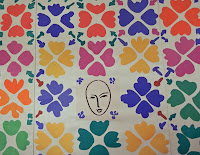 With John T. Scott's preferred jazz tunes playing in the background, the Louisiana Art and Science Museum downtown Baton Rouge invites the visitor to look at the artist and his colleagues' works during the exhibition Rhythm and Improvisation: John T. Scott and his Enduring Legacy.
With John T. Scott's preferred jazz tunes playing in the background, the Louisiana Art and Science Museum downtown Baton Rouge invites the visitor to look at the artist and his colleagues' works during the exhibition Rhythm and Improvisation: John T. Scott and his Enduring Legacy.The display of a collection of sculptures and wall pieces on the ground floor places the emphasis on John Scott, the sculptor. The gathering in one room could be oppressive but the arrangement by series and the wide space allows a walk through to appreciate each work in its context. Several pieces from the Circle Dance Series, monochrome with their characteristic patina evoke music, dance and were included in a previous exhibition Beyond Black at the Shaw Center for the Arts in 2011.
In the middle of the room, a number of painted sculptures from the eighties and nineties are all about Scott's mindset. Sacred Music for Sonny Stitt, 1991, Fragment Dance, 1990, Summershine, 1984... lines, circles, arcs, squares give shape to rhythm in space and bold sometimes discordant colors fuse in harmony. One cannot avoid thinking of artists like Kandinsky, Schoenberg at the beginning of the twentieth century and the intellectual undertone of their synaesthetic experiences. Scott's art is more physical in inducing a relationship between auditory and visual, he is not listening to a colored note but to music which he translates into a composition, rhythm and all. The present is already past and anticipates the future, "jazz thinking" brings dynamic to the works.
 Dancing at the Crossroads (1996), a representation of the crossroads between human and spiritual worlds, the Lush Life Series, 1998, eight chrome plated aluminum wall sculptures paying homage to Bill Strayhorn, Storyville series, 1978, Diddlie Bow series, 1980 and more, contribute to this rich exhibition.
Dancing at the Crossroads (1996), a representation of the crossroads between human and spiritual worlds, the Lush Life Series, 1998, eight chrome plated aluminum wall sculptures paying homage to Bill Strayhorn, Storyville series, 1978, Diddlie Bow series, 1980 and more, contribute to this rich exhibition.Along the way, comments about Scott's life, his motives, including the list of his favorite jazz players and musical scores, give an insight into the artist's inspiration. When working in his studio or teaching, music was always in the background.
On the way to the second level, visitors are gathering to look at a video of Scott projected on a giant screen and on top of the stairs, a large print Olympia Brass Band, 2002, and three collages remind us that the artist was also a painter, made prints and included other media in his works.
Scott's legacy brings the visitor to the second part of the exhibition, a gathering of colleagues, friends, students with a presentation of samples of their works. The comments regarding Scott's influence on their own creativity, their relationship with the artist, infuse a personal touch to the show.
"Ethic, creative courage, wisdom, sacred work" the words define a deep respect and love for their mentor or/and friend: Frank Hayden, Ron Bechet, Jeffrey Cook, Lyndon Barrois... the list goes on and the space is filled with works illustrating the same "critical thinking" which allowed them to fly on their own and thrive. An abstract representation of the famous saxophonist and his music, Stitt from Martin Payton, made of heavy steel but light like a feather, defies the laws of gravity. Clifton Webb's intriguing Eye of the Storm about the awe inspiring nature evokes a sacred object, a magical instrument, concentrating light and energy and spreads its shadow on the walls. Paintings, prints, sculptures, the abundance of works makes it impossible to comment on each of them, but each helps us connect with Scott as we discover their own flavor and Scott's ongoing legacy.
"Homage to John Scott" may be too deferential, one finds warmth, fondness, love and the show ends up being a celebration of Scott's life, thanks to his friends.
photographs by the author
"Circle Dance: Lil' Bone for T. Bone", 2001
"Eye of the Storm", 2007, Clifton Webb
View of the exhibition










